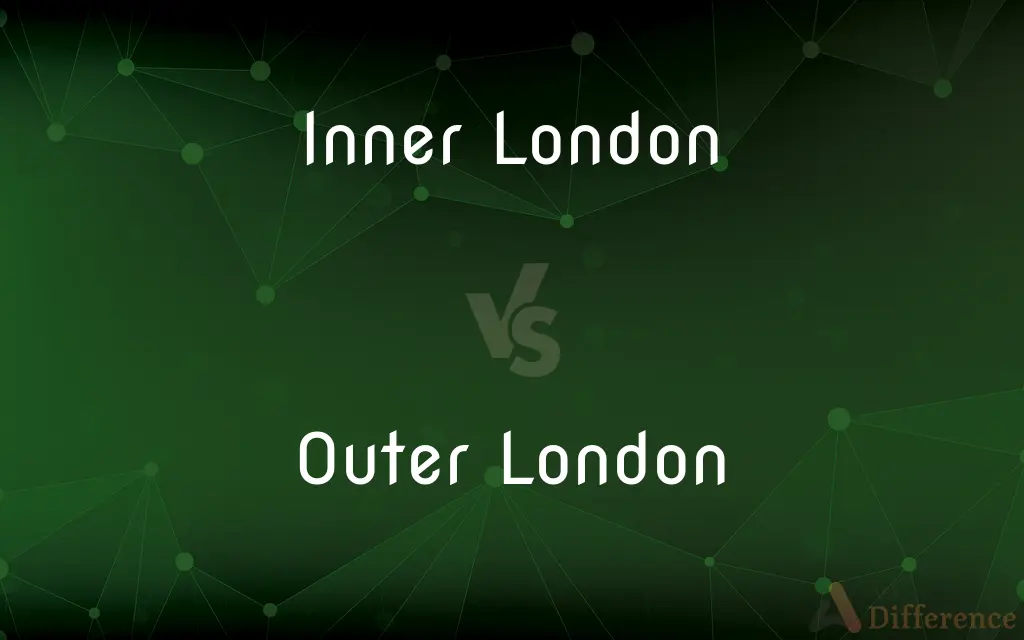Inner London vs. Outer London — What's the Difference?
Edited by Tayyaba Rehman — By Fiza Rafique — Updated on April 22, 2024
Inner London is the central area, known for its historic landmarks and economic activities, while Outer London surrounds it, characterized by more residential areas and green spaces.

Difference Between Inner London and Outer London
Table of Contents
ADVERTISEMENT
Key Differences
Inner London represents the central part of London, historically and economically significant, encompassing areas like the City of London and the West End. It's characterized by higher population density, iconic landmarks, major government institutions, and a concentration of cultural and financial activities. Outer London, on the other hand, forms a ring around Inner London, featuring a mix of residential suburbs, larger green spaces, and lower population density. This area includes boroughs like Croydon and Bromley, providing a more suburban lifestyle compared to the urban core.
The distinction between Inner and Outer London is not just geographical but also socio-economic. Inner London has a higher cost of living, with property prices and rents significantly higher than in Outer London. This is partly due to the proximity to central business districts and attractions. Outer London offers more affordable housing options, attracting families and individuals looking for more space and a quieter environment.
In terms of transport, Inner London benefits from a dense network of public transportation options, including the London Underground, buses, and cycling routes. Outer London, while still well-served by public transport, relies more on commuter trains and buses, with some areas less accessible compared to the city's center.
Educationally, Inner London boasts a wide array of prestigious universities, colleges, and cultural institutions, attracting students and professionals from around the world. Outer London also offers educational and cultural opportunities, though with a focus more on community and local services than the global or national scale found in the center.
The lifestyle in Inner London is often described as fast-paced, with an abundance of dining, shopping, and entertainment options, catering to a diverse, cosmopolitan population. Outer London provides a contrast with its more relaxed pace, community-oriented lifestyle, and access to nature, appealing to those seeking a balance between urban conveniences and suburban comfort.
ADVERTISEMENT
Comparison Chart
Location
Central area of London
Surrounds Inner London
Characteristics
High population density, historic landmarks
More residential, larger green spaces
Cost of Living
Higher
Lower
Housing
Expensive, less spacious
More affordable, more spacious
Transport
Dense public transport network
Relies more on commuter trains and buses
Education
Prestigious universities, cultural institutions
Focus on community and local services
Lifestyle
Fast-paced, cosmopolitan
Relaxed, community-oriented
Population Density
Higher
Lower
Compare with Definitions
Inner London
Higher cost of living due to proximity to major attractions.
Renting an apartment in Inner London is significantly more expensive.
Outer London
More affordable and spacious housing options.
Many move to Outer London for a larger home at a lower cost.
Inner London
Features high population density and a fast-paced lifestyle.
Inner London is bustling with activity day and night.
Outer London
Transport relies more on commuter trains and buses.
Commuting from Outer London to the city center is common for work.
Inner London
The central area, known for iconic landmarks like the Houses of Parliament.
Tourists flock to Inner London for its historic sites.
Outer London
The suburban ring surrounding Inner London, known for its green spaces.
Families enjoy the parks and playgrounds in Outer London.
Inner London
Dense public transport network for easy mobility.
Residents often use the Tube to navigate Inner London.
Outer London
Offers a more relaxed, community-oriented lifestyle.
Outer London neighborhoods are known for their strong community ties.
Inner London
Hub for cultural, financial, and educational institutions.
Inner London is home to world-renowned universities and museums.
Outer London
Focuses on local services and community education.
Outer London boasts numerous community colleges and local initiatives.
Common Curiosities
How does the cost of living compare between Inner and Outer London?
The cost of living in Inner London is higher than in Outer London, reflecting the premium for proximity to central amenities and attractions.
What are the educational differences between Inner and Outer London?
Inner London hosts prestigious universities and cultural institutions, while Outer London focuses more on community and local educational services.
Can you commute easily from Outer to Inner London?
Yes, while Outer London relies more on commuter trains and buses, the public transport network facilitates relatively easy commuting to Inner London.
Is Outer London less culturally vibrant than Inner London?
While Outer London may have fewer global cultural attractions, it boasts a rich local cultural scene with community events, local theaters, and art galleries.
What defines Inner London?
Inner London is defined by its central location, dense urban environment, historical significance, and concentration of economic activities.
Why might someone choose to live in Outer London?
People might choose Outer London for more affordable housing, a quieter lifestyle, and access to green spaces, balancing urban conveniences with suburban comfort.
What is the lifestyle like in Inner London?
Inner London offers a fast-paced, cosmopolitan lifestyle with abundant dining, shopping, and entertainment options catering to a diverse population.
Are there green spaces in Inner London?
Yes, despite its urban density, Inner London has notable green spaces like Hyde Park and Regent's Park, offering recreational areas amidst the cityscape.
What makes Inner London attractive to businesses and professionals?
Its status as an economic and cultural hub, with access to a global network, prestigious institutions, and a skilled workforce, makes it attractive.
What characterizes Outer London?
Outer London is characterized by its suburban areas, lower population density, more affordable housing, and larger green spaces.
Is there a difference in community atmosphere between Inner and Outer London?
Outer London is often perceived as having a stronger sense of community and a slower pace of life compared to the more transient, bustling nature of Inner London.
Can Outer London provide a good quality of life?
Yes, many find Outer London offers a high quality of life, combining affordability, access to nature, and community with the convenience of urban living.
How does public transport accessibility differ between Inner and Outer London?
Inner London benefits from a denser network of Tube stations and bus routes, while Outer London areas may be less accessible, relying more on commuter rail services.
What drives the economic differences between Inner and Outer London?
The concentration of financial, governmental, and cultural institutions in Inner London drives its economic activity, while Outer London's economy is more varied, including business parks, retail, and local services.
How do housing styles differ between Inner and Outer London?
Housing in Inner London tends to be more compact and expensive, while Outer London offers a variety of styles, from suburban houses to modern apartments, generally offering more space for the price.
Share Your Discovery

Previous Comparison
Strainsblue Dream vs. Pineapple Express
Next Comparison
Central Government vs. State GovernmentAuthor Spotlight
Written by
Fiza RafiqueFiza Rafique is a skilled content writer at AskDifference.com, where she meticulously refines and enhances written pieces. Drawing from her vast editorial expertise, Fiza ensures clarity, accuracy, and precision in every article. Passionate about language, she continually seeks to elevate the quality of content for readers worldwide.
Edited by
Tayyaba RehmanTayyaba Rehman is a distinguished writer, currently serving as a primary contributor to askdifference.com. As a researcher in semantics and etymology, Tayyaba's passion for the complexity of languages and their distinctions has found a perfect home on the platform. Tayyaba delves into the intricacies of language, distinguishing between commonly confused words and phrases, thereby providing clarity for readers worldwide.














































